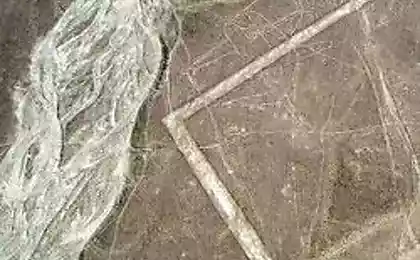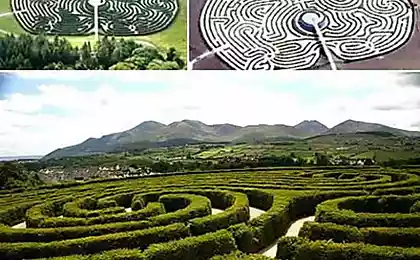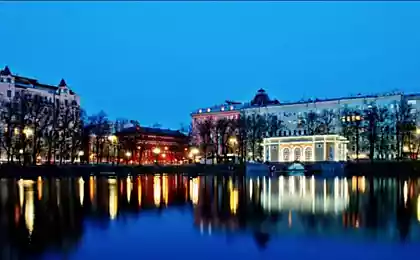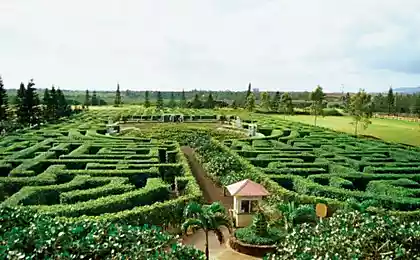2029
Russian mazes
Churchill said: "Russia - a riddle wrapped in a mystery inside an enigma placed." A little more precise Briton: Russia - a maze consisting of many labyrinths placed inside the maze. And in each maze you wait own "minotaurs».
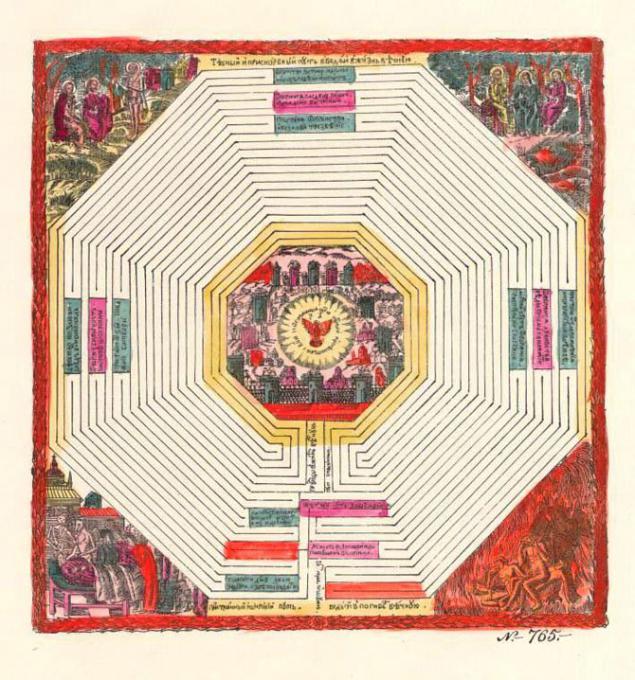
"Labyrinth Spiritual»
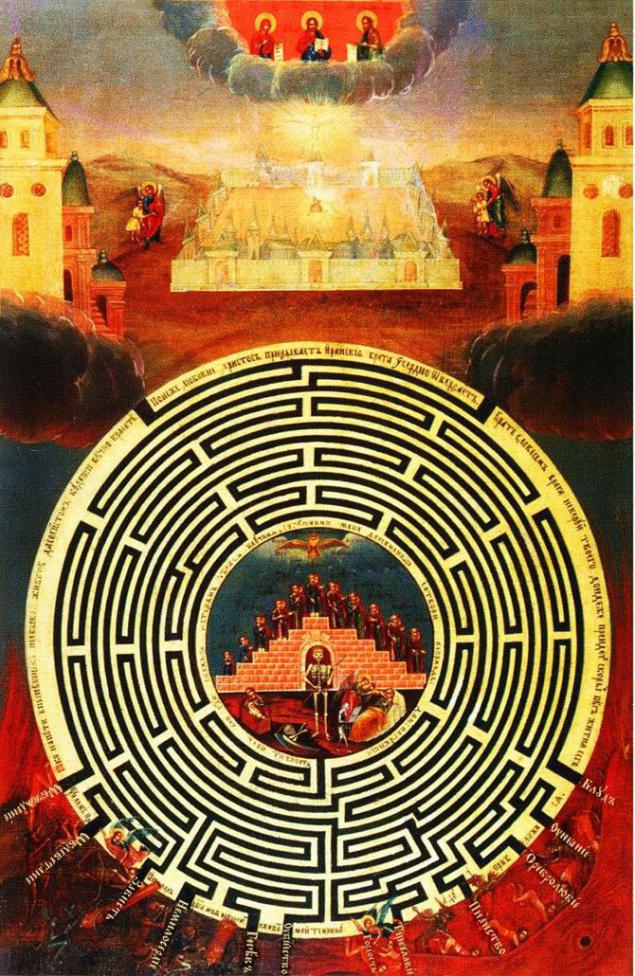
This is an icon written in the XVIII century, you can see in the New Jerusalem Monastery. The image is very unexpected for Russian iconography: knowledgeable people say about the influence of the Western Christian tradition. Although it is not fundamentally.
"Spiritual Labyrinth" includes 12 laps: two entrances lead into the kingdom of heaven, and twelve - in hell. Icon serves as a kind of detector sinfulness: submit visually from the center of the road, you will be rested it in his major sin. This, of course, does not apply to the righteous ...
People said that the passage "Labyrinth Spiritual" only before confession (and once at a time). Otherwise, you can fall into a charm or even fall into madness.
"Kandalakshsky BABYLON»

"Babylon" - the so-called labyrinths in the Russian North, where, incidentally, there were many. There is a version that originally they were called "Avalon" (in honor of the Celtic mythical island of the blessed), and then, with the advent of Christianity, in consonance - "Babylon". Some believed that ancient people in these structures may offer sacrifices of others - a place for initiations, the third - the place of power, where a person can go into another dimension. It was even believed that this fish traps, which fell into the maze during high tide.
It is not known what the function was originally performed "Babylon", built on the shore of the Gulf of Kandalaksha 3-5 thousand years ago. It is known that the Sami performed here their shamanic rituals at the beginning of the last millennium. Then this is the place inhabited Russian coast-dwellers, who by "Babylon" treated very cautiously. It was believed that the "journey" through the labyrinth can result in a descent into hell. True, they say, Pomorie-conservatives still enjoyed "Babylon" before maritime navigation: say, by means of the labyrinth can be controlled by the winds.
"UMBSKY BABYLON»

Near the river Umba (near Kandalaksha) can find another "Babylon". Probably, this functionality does not differ from the neighboring Kandalakshsky maze. Locals said that "Babylon" stands on the old Sami cemetery, and the passage of the labyrinth can result in unwanted contact with the ancient spirits.
Big Solovetsky LABYRINTH

This maze is located on the Big Solovetsky Island. It consists of two interlaced snakes. Regardless of which way you go, you always go back to the place of entry.
There is a belief associated with this "Babylon": popular rumor said that it promotes a doubling of "material" values. For example, if you walk the labyrinth with 10 rubles in his pocket, then your capital will soon grow to 20 rubles. People scientists, "investment" version is called, of course, nonsense.
PYSKORSKY LABYRINTH
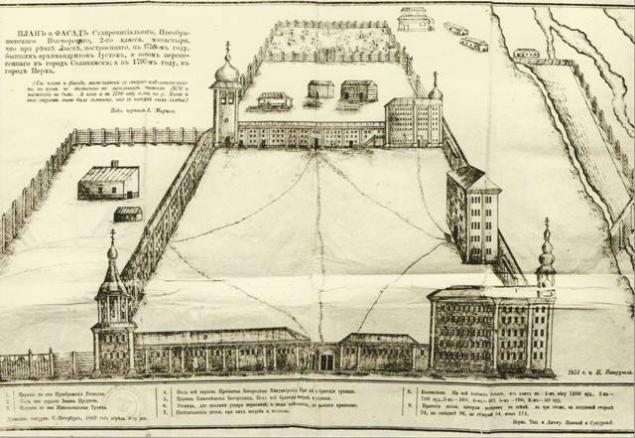
This maze was accidentally discovered in 1915 in the Urals, under Pyskorskoy mountain. In his time on the mountain stood Pyskorsky monastery generic monastery famous Stroganoff. Under the monastery monks established a system of tunnels and underground chapels, secret cells, warehouses and other facilities. Explore the maze more thoroughly and failed, because soon the only underground passage to it was closed landslide. Interestingly, the locals have long been legends about hidden treasures in the mountain, with some pyskortsam in his sleep from night to night came a old man and pointed out the place of the treasure.
"SAD at the pavilion Tempel»
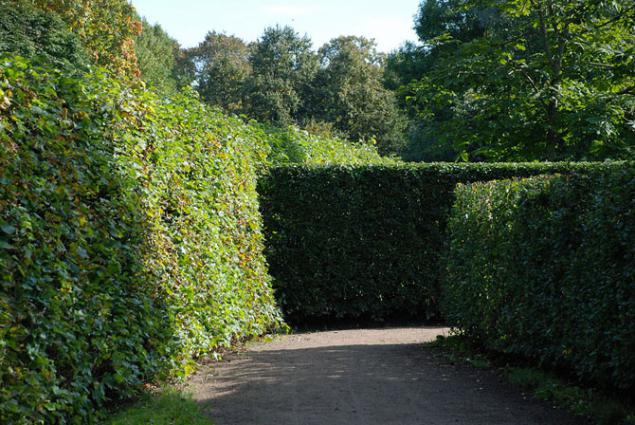
Peter I was a big fan of mazes. They say that by order of the king-modernist was built no less than ten facilities throughout Russia. Peter even credited with creating some "Babylon" in the White Sea, which archaeologists have allegedly mistakenly take today for the construction of the Neolithic. But this is all speculation. With full confidence can be attributed to Peter Alekseevich authorship only one labyrinth - Peterhof, which was created according to the plan of the French specialist Jean-Baptiste Leblond. Maze, called "The Garden Pavilion at the Temple", was an almost square area of about 2 hectares. At its center is an oval swimming pool, from which the costs eight tracks; they crossed the circular walkway separating the land into sixteen groups of trees, which were planted flowers. Despite the "vegetable" origin of the maze was not quite so harmless: it was rumored that some of the "travelers" there disappear without a trace. According to another legend, "The Garden Pavilion at the Temple" eventually chosen by the first Russian Masons, who conducted it their secret rituals.
MOSCOW LABYRINTH

According to research by the famous Russian archaeologist and researcher "Moscow underground" Ignatius Stelletskogo, underground structures under the buildings XVI - XVII centuries located within the Garden Ring, linked with the Kremlin and the network of underground labyrinths. And the plan was originally an underground capital was created by Italian architects of the Moscow Kremlin - Aristotle Fioravanti, Pietro Antonio Solari and Aleviz New. Stelletsky in particular, wrote: "All three architects as foreigners could not leave Moscow and had it folded their bones ..." Archaeologists have discovered a coherent system of underground 350 points, thanks to which, for example, you could get from the Kremlin on the Sparrow Hills. However, after the death of Stelletskogo study were classified.
source

"Labyrinth Spiritual»

This is an icon written in the XVIII century, you can see in the New Jerusalem Monastery. The image is very unexpected for Russian iconography: knowledgeable people say about the influence of the Western Christian tradition. Although it is not fundamentally.
"Spiritual Labyrinth" includes 12 laps: two entrances lead into the kingdom of heaven, and twelve - in hell. Icon serves as a kind of detector sinfulness: submit visually from the center of the road, you will be rested it in his major sin. This, of course, does not apply to the righteous ...
People said that the passage "Labyrinth Spiritual" only before confession (and once at a time). Otherwise, you can fall into a charm or even fall into madness.
"Kandalakshsky BABYLON»

"Babylon" - the so-called labyrinths in the Russian North, where, incidentally, there were many. There is a version that originally they were called "Avalon" (in honor of the Celtic mythical island of the blessed), and then, with the advent of Christianity, in consonance - "Babylon". Some believed that ancient people in these structures may offer sacrifices of others - a place for initiations, the third - the place of power, where a person can go into another dimension. It was even believed that this fish traps, which fell into the maze during high tide.
It is not known what the function was originally performed "Babylon", built on the shore of the Gulf of Kandalaksha 3-5 thousand years ago. It is known that the Sami performed here their shamanic rituals at the beginning of the last millennium. Then this is the place inhabited Russian coast-dwellers, who by "Babylon" treated very cautiously. It was believed that the "journey" through the labyrinth can result in a descent into hell. True, they say, Pomorie-conservatives still enjoyed "Babylon" before maritime navigation: say, by means of the labyrinth can be controlled by the winds.
"UMBSKY BABYLON»

Near the river Umba (near Kandalaksha) can find another "Babylon". Probably, this functionality does not differ from the neighboring Kandalakshsky maze. Locals said that "Babylon" stands on the old Sami cemetery, and the passage of the labyrinth can result in unwanted contact with the ancient spirits.
Big Solovetsky LABYRINTH

This maze is located on the Big Solovetsky Island. It consists of two interlaced snakes. Regardless of which way you go, you always go back to the place of entry.
There is a belief associated with this "Babylon": popular rumor said that it promotes a doubling of "material" values. For example, if you walk the labyrinth with 10 rubles in his pocket, then your capital will soon grow to 20 rubles. People scientists, "investment" version is called, of course, nonsense.
PYSKORSKY LABYRINTH

This maze was accidentally discovered in 1915 in the Urals, under Pyskorskoy mountain. In his time on the mountain stood Pyskorsky monastery generic monastery famous Stroganoff. Under the monastery monks established a system of tunnels and underground chapels, secret cells, warehouses and other facilities. Explore the maze more thoroughly and failed, because soon the only underground passage to it was closed landslide. Interestingly, the locals have long been legends about hidden treasures in the mountain, with some pyskortsam in his sleep from night to night came a old man and pointed out the place of the treasure.
"SAD at the pavilion Tempel»

Peter I was a big fan of mazes. They say that by order of the king-modernist was built no less than ten facilities throughout Russia. Peter even credited with creating some "Babylon" in the White Sea, which archaeologists have allegedly mistakenly take today for the construction of the Neolithic. But this is all speculation. With full confidence can be attributed to Peter Alekseevich authorship only one labyrinth - Peterhof, which was created according to the plan of the French specialist Jean-Baptiste Leblond. Maze, called "The Garden Pavilion at the Temple", was an almost square area of about 2 hectares. At its center is an oval swimming pool, from which the costs eight tracks; they crossed the circular walkway separating the land into sixteen groups of trees, which were planted flowers. Despite the "vegetable" origin of the maze was not quite so harmless: it was rumored that some of the "travelers" there disappear without a trace. According to another legend, "The Garden Pavilion at the Temple" eventually chosen by the first Russian Masons, who conducted it their secret rituals.
MOSCOW LABYRINTH

According to research by the famous Russian archaeologist and researcher "Moscow underground" Ignatius Stelletskogo, underground structures under the buildings XVI - XVII centuries located within the Garden Ring, linked with the Kremlin and the network of underground labyrinths. And the plan was originally an underground capital was created by Italian architects of the Moscow Kremlin - Aristotle Fioravanti, Pietro Antonio Solari and Aleviz New. Stelletsky in particular, wrote: "All three architects as foreigners could not leave Moscow and had it folded their bones ..." Archaeologists have discovered a coherent system of underground 350 points, thanks to which, for example, you could get from the Kremlin on the Sparrow Hills. However, after the death of Stelletskogo study were classified.
source


